
Introduction
The Indian fashion and textile industries are dynamic and ever-evolving, playing a pivotal role in the country’s economy. In 2024, several exciting trends are set to reshape these industries, making it crucial to stay informed and adapt to the changing landscape.
Brief overview of the Indian fashion and textile industries
India’s fashion and textile sectors are renowned for their rich heritage, craftsmanship, and diverse cultural influences. From traditional handwoven textiles to contemporary haute couture, the industry encapsulates a wide spectrum of creativity and innovation.
Significance of staying updated with industry trends
Staying abreast of industry trends is paramount for professionals and enthusiasts alike, offering insights into consumer preferences, market dynamics, and technological advancements. It enables businesses to align their strategies with emerging opportunities and challenges.
Key Takeaway: Exciting trends to watch out for in 2024
As we delve into the upcoming trends for 2024, you’ll discover the transformative initiatives, technological advancements, and market shifts that are poised to shape the Indian fashion and textile landscape in the year ahead.
1. PM Mitra Mega Textile Park

The PM Mitra Mega Textile Park is set to play a significant role in the Indian fashion industry in 2024. Located in Maharashtra, this textile park aims to boost the country’s textile manufacturing capabilities and attract investments. Here are some key highlights of the Maharashtra Textile Park and the anticipated benefits for the Indian fashion and textile industries:
Overview of PM Mitra Mega Textile Park
The PM Mitra Mega Textile Park is a government initiative aimed at creating a world-class textile manufacturing hub in Maharashtra. It seeks to provide state-of-the-art infrastructure, technology, and facilities to promote textile production and attract domestic and international investments.
Key Highlights of the Maharashtra Textile Park
The Maharashtra Textile Park is expected to span over a vast area and house various textile units, including spinning mills, weaving units, processing plants, and garment manufacturing factories. It will offer integrated services, such as testing laboratories, design studios, training centers, warehousing facilities, and logistics support.
Anticipated Benefits for the Indian Fashion and Textile Industries
The establishment of the PM Mitra Mega Textile Park is expected to have several positive implications for the Indian fashion and textile industries in 2024. These benefits include:
- Enhanced Manufacturing Capabilities: The park’s state-of-the-art infrastructure and advanced technology will enable fashion businesses to improve their manufacturing capabilities. This will result in increased production efficiency, higher quality products, and reduced costs.
- Job Creation: The establishment of the textile park is expected to generate a significant number of job opportunities across various sectors of the fashion and textile industries. From skilled workers to managerial positions, it will contribute to employment growth in the region.
- Attracting Investments: The presence of a dedicated textile park with modern facilities is likely to attract both domestic and international investments. This influx of capital will stimulate further growth and development in the Indian fashion and textile sectors.
- Strengthening Supply Chains: The textile park’s integrated services and infrastructure will support the development of robust and efficient supply chains. This will enable fashion businesses to streamline their operations, reduce lead times, and ensure timely delivery of products.
The PM Mitra Mega Textile Park holds great potential for the Indian fashion and textile industries in 2024. Its establishment is expected to drive growth, innovation, and competitiveness, positioning India as a global leader in textile manufacturing.
2. Production Linked Incentive (PLI) Schemes
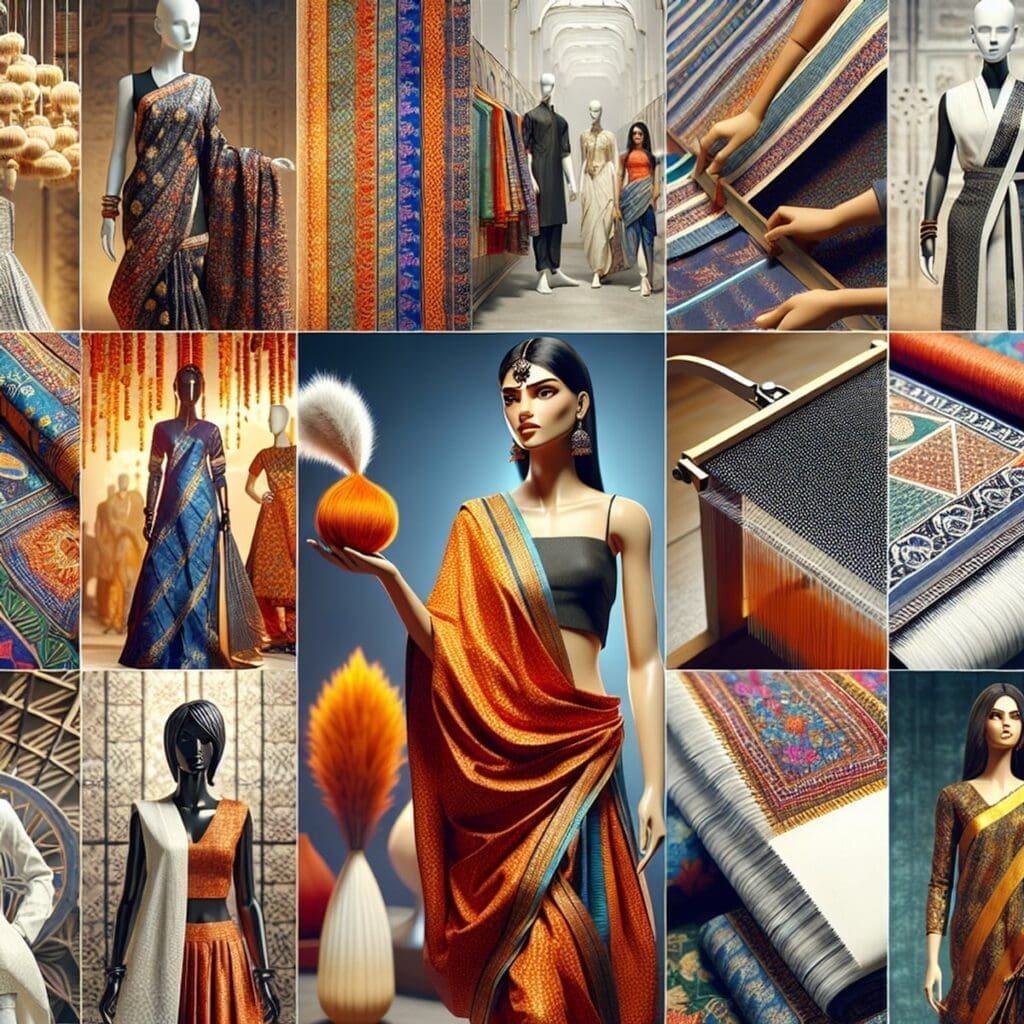
The Indian fashion industry is set to benefit from the government’s Production Linked Incentive (PLI) schemes, which aim to boost manufacturing capabilities and drive economic growth. These schemes were launched at a government scheme event in collaboration with key industry stakeholders.
Understanding PLI Schemes and Their Impact on the Industry:
- The PLI schemes provide financial incentives to eligible companies in order to increase their production capacities.
- These schemes are designed to attract both domestic and foreign investments, thereby stimulating the growth of the fashion industry.
- By incentivizing manufacturers, the government aims to reduce imports and make India self-reliant in terms of fashion production.
Role of PLI Schemes in Boosting Manufacturing Capabilities for Fashion Businesses:
- The PLI schemes encourage businesses to invest in advanced manufacturing technologies, infrastructure, and research and development.
- This will enable fashion brands to enhance their production capabilities, improve product quality, and introduce innovative designs.
- With increased manufacturing capacities, fashion businesses can meet growing consumer demands and compete in both domestic and international markets.
The PLI schemes have the potential to revolutionize the Indian fashion industry by creating a favorable environment for growth and innovation. By incentivizing manufacturers, these schemes will not only boost manufacturing capabilities but also contribute to job creation and economic development. Fashion businesses that take advantage of these schemes will be well-positioned to thrive in the competitive landscape of 2024.
3. Bharat Tex 2024 – Global Textile Expo
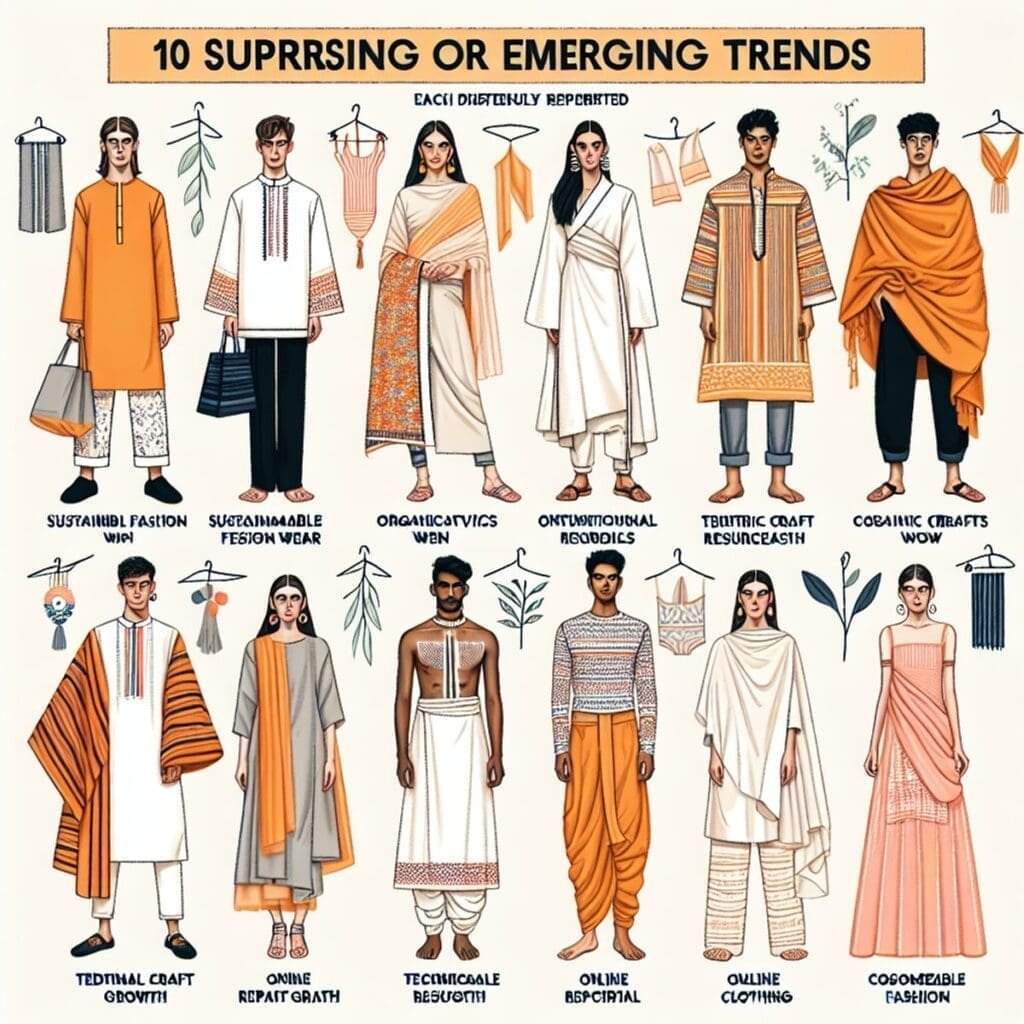
Bharat Tex 2024 is set to be one of the most anticipated events in the Indian fashion industry calendar. This global textile expo will bring together industry professionals, designers, manufacturers, and buyers from around the world to showcase the latest trends and innovations in textiles.
A Sneak Peek into Bharat Tex 2024:
- The expo will feature a wide range of textile products including fabrics, garments, accessories, and home furnishings. It will provide a platform for both established brands and emerging designers to showcase their creations.
- Exhibitors will include manufacturers, suppliers, and exporters from various segments of the textile industry such as cotton, silk, wool, synthetic fibers, and technical textiles.
- Fashion shows, seminars, and panel discussions will be organized to facilitate knowledge-sharing and networking opportunities among industry professionals.
Exploring New Opportunities in Textile Trade at Bharat Tex 2024:
- The expo offers a unique opportunity for businesses to explore new markets and expand their customer base. Buyers from international markets will have the chance to source high-quality textiles directly from Indian manufacturers.
- It also serves as a platform for collaboration between Indian and international designers, fostering creativity and cross-cultural exchange.
- The event is expected to attract a large number of domestic and international buyers, providing an excellent platform for businesses to showcase their products and establish new partnerships.
Bharat Tex 2024 promises to be an exciting event that will shape the future of the Indian fashion and textile industries. It presents a chance for industry professionals to stay ahead of the curve by discovering new trends, connecting with potential business partners, and exploring fresh opportunities in the global textile trade.
4. Embracing Technology: The Future of Fashion Design

The Role of Generative AI in Shaping Unique Fashion Trends
Generative AI, also known as creative AI, is changing the way fashion designs are created. It uses complex algorithms and machine learning to analyze large amounts of data and identify patterns, styles, and consumer preferences. This technology allows designers to think outside the box and be more creative, resulting in new and exciting fashion trends in India.
Challenges and Opportunities in the Face of Fast-Fashion Competition
In 2024, the Indian fashion industry is facing tough competition from fast-fashion brands that quickly copy the latest trends and offer them at low prices. While this may be a challenge for traditional fashion businesses, it also opens doors for innovation and differentiation. By embracing technology and highlighting their unique strengths, fashion companies can stand out in the market and attract discerning customers who value authenticity and individuality.
5. Towards a Sustainable Tomorrow
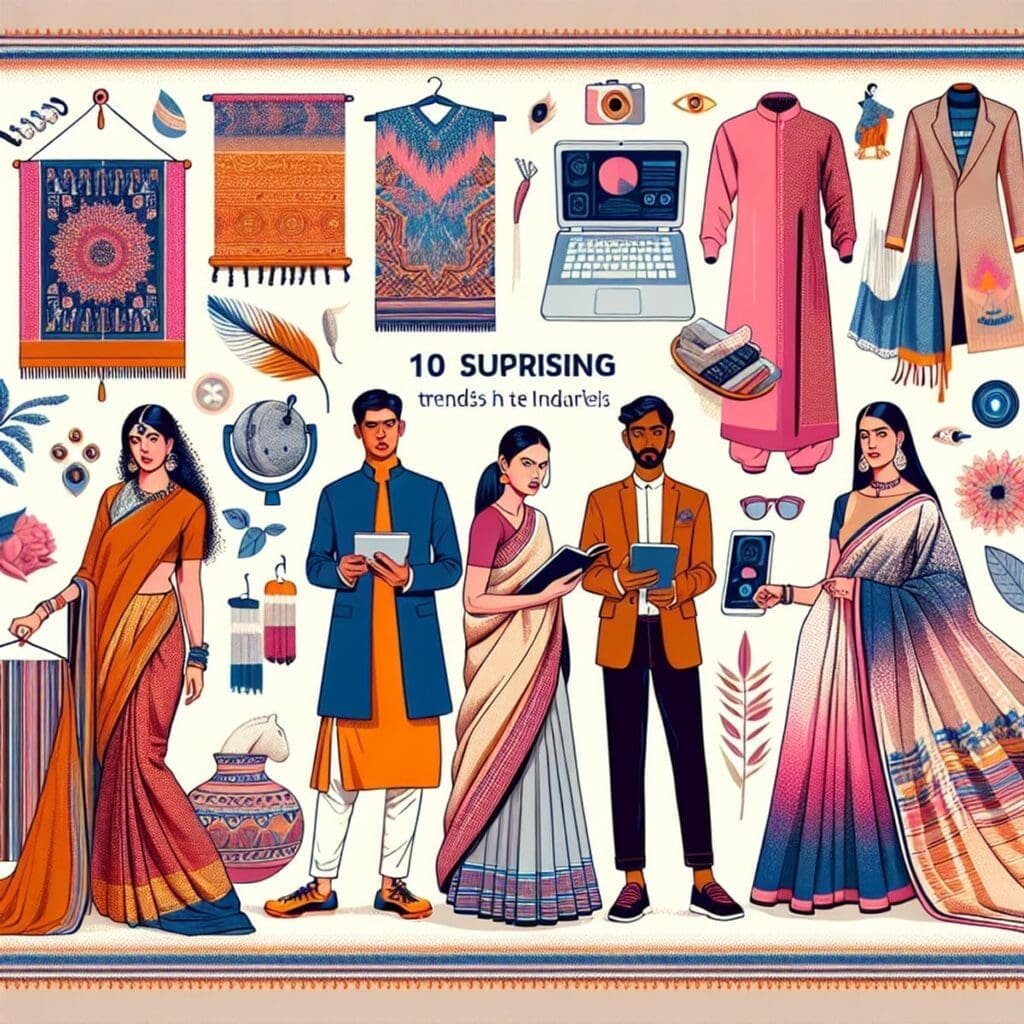
The fashion industry in India is undergoing a significant change towards being more environmentally and socially conscious. There is now a greater emphasis on sustainability and ethical practices, with initiatives being taken to prioritize the well-being of the planet and its people.
Key Areas of Focus:
1. Environmental Responsibility
Fashion brands are actively exploring:
- Eco-friendly materials
- Sustainable production processes
- Innovative recycling techniques
All these efforts are aimed at minimizing their environmental impact.
2. Social Responsibility
The industry is also placing a stronger emphasis on:
- Fair labor practices
- Ethical sourcing
- Supporting local communities
These actions are taken to create a positive social impact.
3. Sustainability in Fashion
The industry is adopting various sustainable practices such as:
- Promoting slow fashion
- Advocating for circular economy principles
These practices benefit both the environment and society.
4. Indian Fashion Industry Sustainability Initiatives
Several Indian fashion brands and organizations are leading the way with sustainability initiatives, setting new standards for responsible and eco-conscious fashion.
This growing focus on sustainability shows a broader commitment to creating a more ethical and environmentally aware fashion industry in India.
6. Navigating Geopolitical and Economic Uncertainties
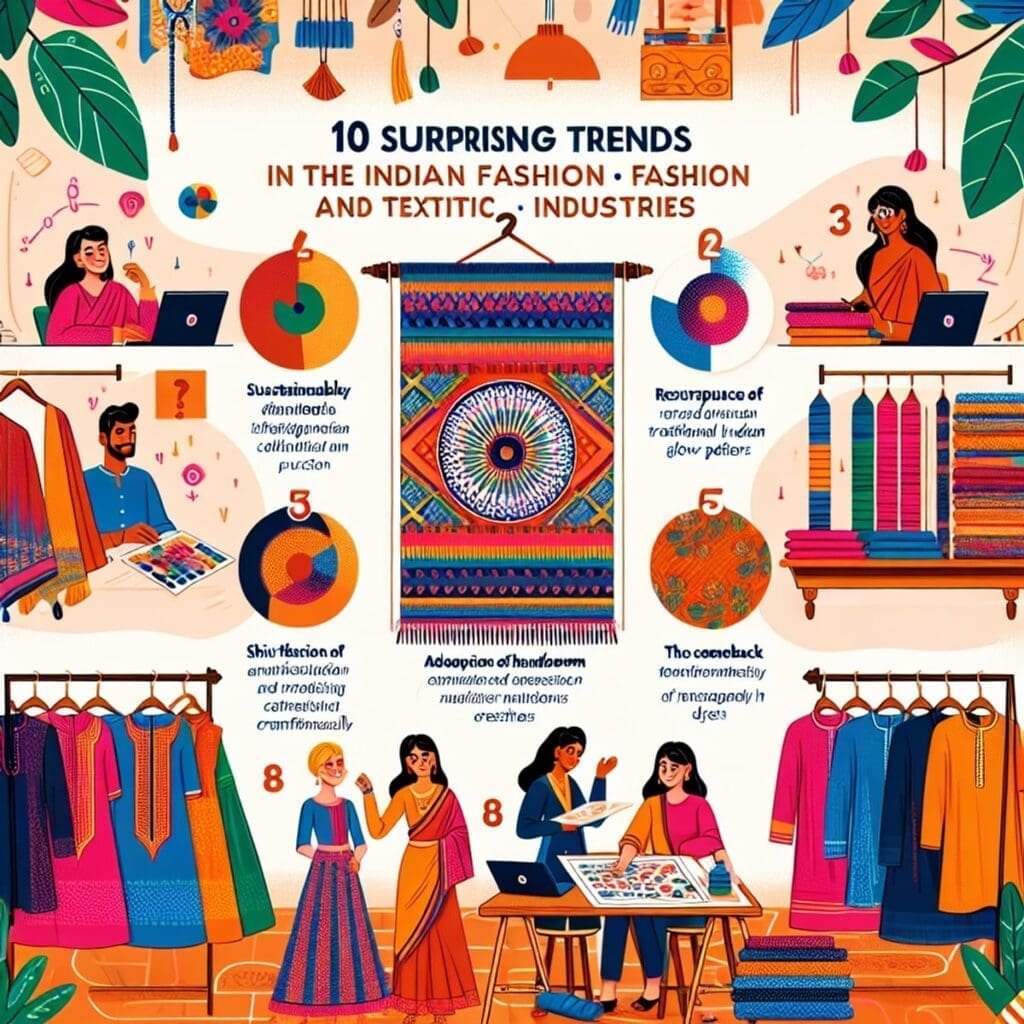
The Indian fashion industry operates in a constantly changing environment influenced by political instability, economic fluctuations, and rising prices. These factors bring both challenges and possibilities for industry players:
Impact of Geopolitical Factors on Sourcing Decisions
Geopolitical tensions can disrupt the supply chain and sourcing decisions, leading to changes in where products are made and who they are traded with. Indian fashion brands must navigate these complexities to ensure a smooth supply chain.
Understanding the Relationship Between Economic Conditions and Consumer Behavior
Changes in the economy directly affect how much money consumers have to spend and how they choose to spend it. As the industry deals with rising prices and uncertain economic times, it becomes crucial to understand how consumers feel in order to make smart business decisions.
By staying aware of political and economic changes, fashion leaders can proactively deal with problems and take advantage of new opportunities in the ever-changing fashion world.
7. The Rise of Technical Outdoor Clothing in India
In recent years, the popularity of technical outdoor clothing styles has soared in the Indian market. This trend reflects the growing interest of Indian consumers in outdoor activities and adventure sports. Technical outdoor clothing offers a combination of functionality, durability, and style, making it suitable for various outdoor pursuits.
Key Factors Driving the Rise of Technical Outdoor Clothing in India
1. Growing demand
Indian consumers are increasingly seeking high-performance apparel that can withstand the rigors of outdoor activities while providing comfort and protection. This has led to a surge in the demand for technical outdoor clothing.
2. Adoption by Indian fashion brands
Many Indian fashion brands have recognized this trend and are incorporating technical elements into their collections. They are designing garments that not only cater to the functional needs of outdoor enthusiasts but also align with the latest fashion trends.
3. Expansion of niche segments
With the rise of technical outdoor clothing, niche segments within the Indian fashion industry have emerged. These segments focus on specialized outdoor apparel for activities like hiking, trekking, mountaineering, and water sports.
4. Collaborations and innovations
To meet the demands of this growing market, collaborations between Indian fashion brands and international outdoor gear manufacturers have become common. These collaborations bring together expertise from both industries to create innovative and high-quality technical outdoor clothing.
5. Increased awareness and accessibility
The advent of e-commerce platforms and social media has played a crucial role in creating awareness about technical outdoor clothing among Indian consumers. It has also made these products more accessible to a wider audience across different regions of India.
The rise of technical outdoor clothing in India showcases the evolving preferences of Indian consumers and their inclination towards embracing an active lifestyle. As this trend continues to gain momentum, we can expect more Indian fashion brands to explore this niche market segment and offer innovative and stylish options for outdoor enthusiasts.
8. Embracing Diversity: Regional and Cultural Influences on Fashion
The fashion scene in India is a beautiful mix of various regional and cultural influences, resulting in a wide range of unique styles. Here are some examples:
North India: Vibrant Colors and Intricate Embroidery
In North India, you’ll find a love for bright colors and detailed embroidery work. Traditional garments like sarees, lehengas, and salwar kameez are often adorned with intricate designs crafted by skilled artisans.
South India: Elegant Drapes and Handwoven Textiles
South Indian fashion is known for its graceful draping styles and handwoven fabrics. The iconic Kanjivaram silk sarees from Tamil Nadu and Kasavu sarees from Kerala are prime examples of the region’s rich textile heritage.
Cultural Diversity: A Fusion of Traditional and Contemporary
India’s cultural diversity goes beyond just its regions. Each state has its own unique traditions, festivals, and clothing styles. This diversity has paved the way for fusion fashion, where traditional elements are combined with modern silhouettes to create stunning outfits that reflect both heritage and current trends.
“Fashion is the armor to survive the reality of everyday life.” – Bill Cunningham
This quote by renowned fashion photographer Bill Cunningham perfectly captures the essence of how fashion allows us to express ourselves and navigate through different aspects of our lives. In the case of India, it becomes even more significant as it showcases the power of fashion in embracing diversity and preserving cultural identities.
Stay tuned for the next section where we explore the impact of social media on the Indian fashion industry.
9. Strengthening Supply Chains for a Resilient Future
In the fast-changing landscape of the Indian fashion industry, it’s crucial for businesses to build strong supply chains that can withstand challenges. Being able to adapt quickly and keep up with market changes can make a huge difference in staying competitive. Here are some key strategies that can help fashion companies improve their supply chain resilience:
- Diversification of suppliers: Relying on just one source for materials or products can be risky. By working with multiple suppliers, fashion companies can reduce the impact of any disruptions and ensure a steady supply of goods, even during unexpected situations.
- Collaborative partnerships: Building good relationships with suppliers, manufacturers, and logistics partners is important for creating a resilient supply chain. When everyone works together and communicates effectively, it becomes easier to handle challenges and find solutions.
- Technology adoption: Using digital tools like supply chain management software, real-time tracking systems, and demand forecasting technology can greatly improve visibility and flexibility in the supply chain. With better access to information, companies can make faster decisions, manage inventory more efficiently, and coordinate activities with different stakeholders.
- Risk assessment and mitigation: Regularly assessing potential risks in the supply chain helps identify areas that need attention. By planning ahead and having backup options in place, such as alternative suppliers or emergency response plans, fashion businesses can minimize the impact of disruptions.
- Sustainability integration: Making sustainability a priority in the supply chain not only meets consumer expectations but also adds resilience. Practices like responsible sourcing, ethical manufacturing, and proper waste disposal reduce environmental risks and strengthen brand reputation.
By implementing these strategies, fashion companies can make their supply chains stronger and better prepared for the future. Being able to adapt quickly to industry changes and effectively manage challenges will be key to success in the coming years.
Note: This section focuses specifically on supply chain resilience and strategies, which is a distinct aspect of the Indian fashion industry’s future trends.
10. Preparing for Success: Strategic Planning in the Fast-Changing Fashion Business
The fast-changing landscape of the Indian fashion industry presents both opportunities and challenges for fashion leaders. To stay ahead and ensure success in this dynamic environment, strategic planning is crucial. Here are some key takeaways from the 2024 trends and advice for fashion leaders to consider:
- Embrace innovation and technology to stay relevant in the ever-evolving market.
- Foster agility and flexibility within your business to respond effectively to rapid changes.
- Stay attuned to consumer preferences and market trends to anticipate shifts in demand.
- Cultivate a culture of sustainability and ethical practices to align with evolving consumer values.
- Collaborate with diverse talent and leverage regional influences to create unique and inclusive designs.
By incorporating these strategies into their planning, fashion leaders can position themselves for success in the future outlook of the Indian fashion industry.
Conclusion
The Indian fashion and textile industries are set to undergo significant shifts and developments in 2024. With a focus on embracing technology, sustainability, and regional influences, the landscape is primed for transformation. As industry professionals, it’s essential to stay proactive and adaptable in the face of these changes.
Here are some key takeaways to stay ahead of the curve:
- Adapting to Change: Embrace the evolving industry landscape for long-term success. Stay informed about emerging trends and be open to integrating new technologies and sustainable practices into your business model.
- Networking and Collaboration: Engage with industry peers, attend events, and participate in collaborative initiatives to gain insights and stay updated with the latest industry developments.
- Strategic Planning: Develop a robust strategic plan that incorporates the identified trends and insights from 2024. This will enable you to navigate challenges effectively while capitalizing on new opportunities.
In conclusion, the Indian fashion and textile industries are entering a dynamic phase with promising prospects for those who are prepared to innovate and adapt. By staying informed, fostering collaboration, and strategically planning for the future, industry professionals can position themselves at the forefront of these exciting trends in 2024.
FAQs (Frequently Asked Questions)
What are some exciting trends to watch out for in the Indian fashion and textile industries in 2024?
The Indian fashion and textile industries are expected to see exciting trends in 2024, including the rise of technical outdoor clothing, the impact of generative AI on fashion design, a growing focus on sustainability and ethical practices, and the exploration of regional and cultural influences on fashion.
What is the PM Mitra Mega Textile Park and how does it relate to the Indian fashion industry in 2024?
The PM Mitra Mega Textile Park is located in Maharashtra and its inauguration is anticipated to bring significant benefits to the Indian fashion and textile industries in 2024. This textile park aims to boost manufacturing capabilities for fashion businesses, contributing to the growth of the industry.
What is the significance of Production Linked Incentive (PLI) Schemes for the Indian fashion industry’s growth?
The launch of Production Linked Incentive (PLI) Schemes is expected to have a positive impact on the Indian fashion industry’s growth. These schemes are designed to boost manufacturing capabilities for fashion businesses, thereby supporting their expansion and development.
What can attendees expect from Bharat Tex 2024 – Global Textile Expo in relation to the Indian fashion industry?
Bharat Tex 2024 – Global Textile Expo offers attendees a sneak peek into new opportunities in textile trade, providing a platform for exploring potential collaborations and advancements within the Indian fashion industry.
How is technology, such as generative AI, shaping unique fashion trends in the Indian fashion industry in 2024?
Generative AI is playing a significant role in shaping unique fashion trends within the Indian fashion industry. It presents both challenges and opportunities in the face of fast-fashion competition, influencing emerging themes and designs.
What are some key initiatives driving sustainability within the Indian fashion industry?
There is a growing focus on sustainability and ethical practices within the Indian fashion industry. Initiatives aimed at environmental responsibility, social responsibility, and sustainable practices are gaining traction as part of an industry-wide commitment to sustainable development.
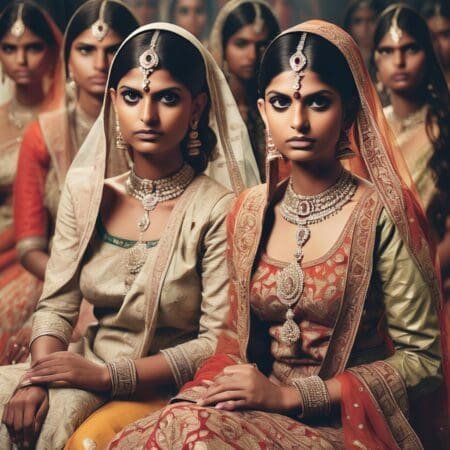


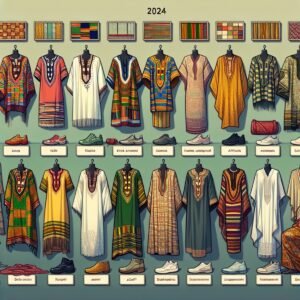



1 thought on “10 Surprising Trends in the Indian Fashion and Textile Industries for 2024”